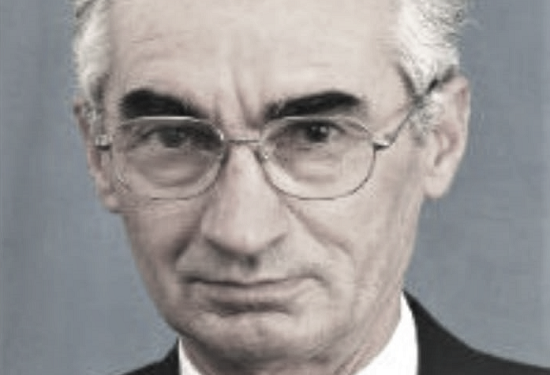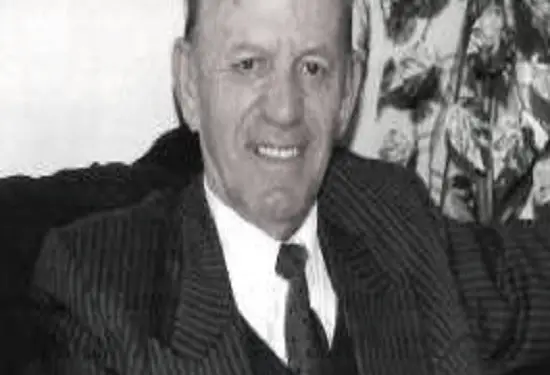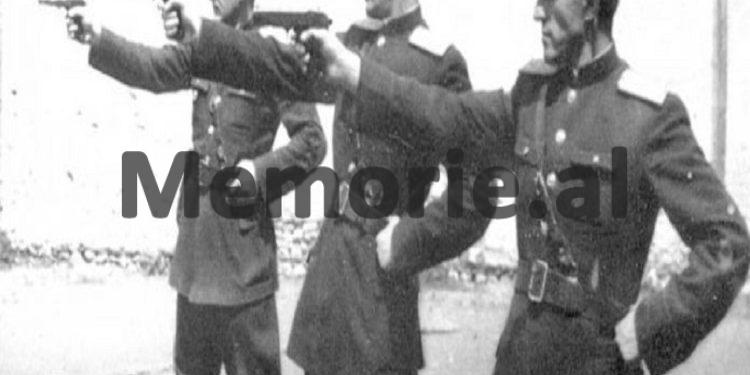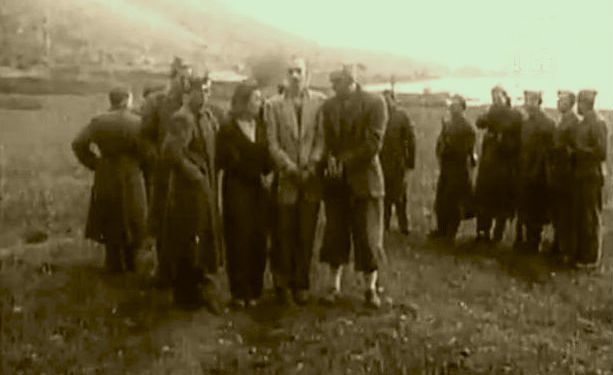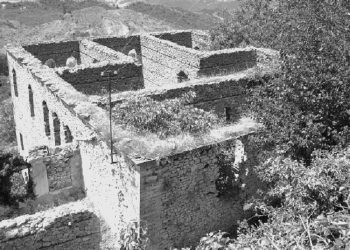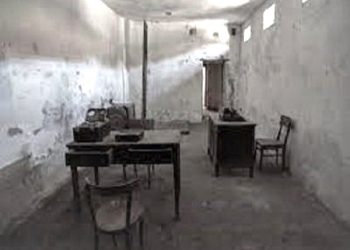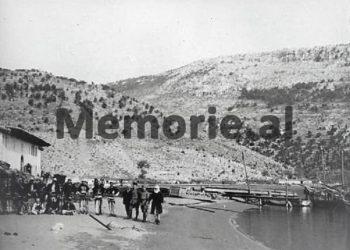By Eugene Merlika
– DICTATORSHIP THROUGH STORIES –
(Impression from reading the volume “The Woman in Black”, by Makensen Bungo)
Memorie.al / “The Woman in Black” is the last contribution of the prose writer Makensen Bungo in the field of a little cultivated field of our letters, that of reporting communist crime in all its manifestations and dimensions. The title of the book coincides with that of the longest story in the volume, carrying within itself the symbolism of a historical era that, in our country, marked with black the lives of many Albanian families. It was not the preferred color of fascism, it was the consequence of the triumph of red, the color of blood, the emblematic color of communism, which, through its destructive work of the “old world” and the construction of the “paradise of childhood”, wore black many Albanian women and girls, cruelly sending their sons, husbands, brothers and loved ones to the next world. This was the most visible conclusion of that monstrous ordeal that appeared on the historical stage of Eastern Europe in the guise of the winner of the war and which, unfortunately, even after ten years of failure and cruelty, even after its tragicomic end, for the most part of the opinion of the old continent, basically remained unpunished, clothed with an ideal halo that could not be defiled by the “mistakes” of individuals.
The author lived first-hand the entire time frame of the communist experience in his homeland, suffering its violence in many directions. As an Albanian, raised and formed in the patriotic anvil of the teachers of the “Normal” school in Elbasan, he quickly became aware that the national interests, so selflessly defended by the signatories of the Vlora act, were trampled by the “leaders of Albania” ” to abandonment, even worse, to criminal collaboration with the gravediggers of the “Albanian issue”.
As a citizen, a dreamer of a free and democratic country, he saw that his best sons, those who intended to establish Albanian democracy after the Western image, ended up, in the vast majority of them, in the execution squads, in the dark cells. , in torture chambers, in forced labor camps or in nameless graves. As a man he quickly realized that: the “new order” was inclined not to respect the moral norms of the Albanian society, but intended to replace them with a system of rules and laws borrowed from the experience of Bolshevik Russia, a beacon of light and a model for to imitate the Albanian communists.
This triple disappointment has accompanied the author of the book during the decades of the system, causing him to accumulate in his memory many events and episodes, like a kind of documentary film that, with some instant reworking, thankfully, is served to Albanian readers today. Testimonial value merges with literary value, to give the reader not love novels with a happy ending, but stories that take your breath away and make you think long to yourself about a world outside the contours of normal logic, which thankfully belongs of Albania’s past, but which still remains alive in other parts of the world. The author does not borrow the militant spirit from “socialist realism”, does not turn the stories into demagoguery attacking the system, and preserves the classic form of the narrative, although sometimes the narrator gives way to the publicist, damaging her line.
The volume “The Woman in Black” consists of ten stories, whose subjects are real events, lived or reported, in which the author’s fantasy works a little, leaving more room for the observational and descriptive ability of the environments and characters of the characters. The first one is entitled “Uncle Thanasi” and describes the environment of the southern village during the war, with the fluctuations of people to get involved in the different military and political currents of the historical moment. The topic refers to the time “when the foundations were laid”, if I were to paraphrase the title of a book from many years later by the main protagonist of that above-human enterprise of deception, which cost Albania and its inhabitants so much.
At the center of the story is the figure of uncle Thanas, the authentic Albanian, for whom the interests of the homeland condition every decision of his personal life. The last is “The Bride from the Mountains”, a chilling description of one of the tragedies of the rafts in the Adriatic Sea, whose watery abyss swallowed the lives of Albanians along with their dreams for the future outside their homeland, after the collapse of the ruins of socialism of Ramiz Ali, gave them freedom, but not the hope to live normally in their country. In this story, the great concern of the patriotic writer about the fate of post-communist Albania is touched upon.
“The youth of Albania is gone bored, desperate, tired, betrayed, and hopeless. Run, run, and run. While Albania was growing old and graying prematurely from day to day…! It is a powerful cry of disappointment and despair that reminds us of the famous elegy of Pashko Vasa, another proof of the function of Albanian writers from the tribune.
Both stories are at the edges of a parable of a social and political system that began with fratricidal gunfire in the early 1940s and ended with the collapse of a monument in the center of Tirana in February 1991, together with the devastating consequences of a failure that caused Albania the biggest expatriate hemorrhage in its history. Between these two ends, other subjects are elaborated, different manifestations of the violence of real socialism of the Albanian brand.
Apostol Gega is the character of the story entitled “White Death”, he is a young teacher who counteracts the regime’s tendency to establish a dictatorship and to deny the patriotic values of the Albanian environment. He is one of the true heroes, whose life does not hurt, if it is put in danger, when it comes to unfolding and protecting ideals, one of those who know how to live but also die with dignity. Unfortunately, they still do not find their place in the Pantheon of the historical memory of their people, because in the official opinion they still fluctuate between “lawbreakers” and victims of violence. Marku of the story “Prisoner’s Song” is one such, in my opinion, one of the most accomplished not only in volume but also in the genre of the Albanian story.
It evokes the Albanian tradition that contradicts the “new order”. They are two worlds that do not agree. The character is mountainous and noble, for whom the friend is sacred and inviolable. His submission to the government is a sacrilege, an unacceptable moral death. This is the lesson that the tradition of the mountains has passed on from generation to generation, it is synonymous with personal and family honor. Its violation is inconceivable for the mountaineer’s mentality; it has become a dogma, which only the “sons of Stalin” try to break through the unparalleled violence of the cult of death.
Marku is sentenced to death after he took shelter at home and escorted out of the border by a family friend followed by the State Security. The act reminds the reader of the long anti-communist resistance of the freedom fighters in the northern mountains and the active role of the inhabitants of those parts in its support. They are glorious pages which, when the true history is written, will form a strong motive of legitimate pride to our whole nation.
The end of the story resembles a grand symphony. The song emerged from the depths of the dungeon of the condemned to death and, at the same time, from the depths of a soul killed not so much by the shackles as by longing for the mother, wife and small children, it echoes a litany that originates from the wooded earth it is distributed over all its inhabitants inside and outside the barbed wire. The song bequeaths you into the atmosphere of the ancient ballads, a kind of tragic continuation that comes down to modern times.
The story “Mother” is dedicated to the theme of the political prison, the most prominent symbol of the violence of the “dictatorship of the proletariat”, which touches on a topic as well-known as it is unbeaten, that of the role, endurance and sacrifice of the Albanian woman in the context of in the long run of communist persecution. They were the true silent heroines of resistance to the violence of the regime. They were the ones who faced the investigators and the police through the doors of the internal affairs branches, or prisons and labor camps, in the role of women, mothers, sisters, ready for the most sublime sacrifices, inclined to protect love to the extreme theirs.
The mother of Makensen Bungo’s story, in front of the arrogant and complacent investigator, who with the cynicism of a criminal communicates the death sentence of her 18-year-old son, arrested in the gymnasium, finds no other weapon to fight than the spit that he throws at her the muzzle. That spit is not just an expression of hatred to the point of contempt of a woman who feels attacked in the most precious thing she has, her only son. That spit is an expression of resistance, of rejection of an entire system that is based on violence, injustice and fraud. It does not remain only on the face of the investigator, but is forwarded to his superiors to the leading bodies of the State.
The rejection of the system, the moral and civil separation with it is also the leitmotif of other stories and their characters. This is how the figure of teacher Donika stands out in “Letter of Praise” or of Mother Labe in the story of the same name. These deal with “lighter” topics. The characters are not soul-searching investigators or prison guards, but teachers who, following the “party line” at school, leave the child in class because his father has escaped, or deny him merit in his studies because his brother is in prison. At first glance, they seem like small follies that were often worn by one or the other, but how many tens of thousands of such cases have been observed in the almost half a century of the regime.
How many hundreds of thousands of children have grown up under the pressure of the “class difference” complex, worse than the racial one, of the ghettos, of the Soviets, they have grown up suppressed, without initiative, without the concept that they are human beings equal to others . Here is one of the motives because the class of the former persecuted, with the arrival of the long-awaited changes, was not able to be properly represented in the political struggle, apart from the strategy prepared by the holders of power. Are there units of measure to measure the damage inflicted on these creatures, the spiritual wounds inflicted in the toy age? Does the conscience kill any of the large army of teachers who, in many cases, became carriers of that ideology that saw in a child a “class enemy”, a shooting board?
It is true that everyone had to earn a living through their profession, but there were different ways to enforce the ordinances without killing the children’s morals. I don’t know where the balance would lean in a calculation of the “good” and the “bad”, but from personal experience I think it would lean towards the former. The author, a former teacher, tries to be objective in the judgment of his colleagues. Teacher Donika says “They have no shame! Dealing with a child. “, while Mother Labe, who sums up in herself all the wisdom, generosity and virtues of elderly Albanian women, regretfully says: “What is the fault of the deserted children?”. They are simple proofs of resistance to evil and, not coincidentally, they are figures of women who personify it.
They are part of that female mosaic that is enriched in volume with the bright figure of the Martyr, whom the reader knows through the impressions of her mountain companion. They are figures who belong to the generation of youth during the war, on which the sword of the dictatorship fell with great force. Their portrayal is easier, they embody the values of the enlightened conservative civic tradition or the peasant patriarchal one, they have iron principles of education that give them an unusual inner strength, capable of coping with any situation, even the most tragic.
But the author does not see virtue only in his generation. In the story “A rainy winter night” he describes the generosity and humanity of the young boys and girls of Tirana, who have the opportunity to meet the prisoners released from political prisons and, in order to help them, do not hesitate to take them in their homes. It is the noble gesture of the “youth of Albania” that honors former convicts, more an expression of respect for the victims of violence than mercy for people left in the middle of the road on a rainy night.
Martirja is the figure of one of the most prominent girls of Albania in the 40s, endowed with deep culture as a result of Italian studies and diploma, mixed with democratic and progressive ideas, enemy of dictatorships of any color. The author is inspired by the figure of the writer Musine Kokalari, one of the most prominent women in the intellectual elite of Albania at that time. This girl who best symbolized the European future of her homeland, ended up in the cells of the Security, in torture, in punishments and, after they were over, she ended her life in a small town as a construction worker and when she died she was sent to the last apartment with a gravel machine…! The evidence of the persecution of this woman and others like her would be enough to accuse Enver Hoxha’s entire system of “crimes against humanity”, after the annihilation of the intellectual potentials of a people is an assassination of its very being.
“She was a lady above all ladies, above all she was noble”, says the author through her friend. It is the highest assessment that can be given to man, the assessment of the spiritual world, of the born and acquired virtues, in front of which the dictatorship suffered the deepest defeat, because despite the use of all the means of cruelty, that world is not managed to defile them. The nobleman remained like that even while taking out the ore wagons in Spaç, even pushing the mortar cart, even sweeping the roads, even digging ditches in the fields. But how many such people did communism kill and maim in Albania, how many quality human activities were denied to the issue of civilization and progress of our country…!
Today, after nearly twenty years of changing the system, no one answers, regrets, or apologizes for these monstrous crimes. How nicely the proponents of “political correctness” inside and outside Albania covered things up, just like once in Europe, when in order to “reduce the tension”, it was forbidden to talk about the gulags and death camps, let alone millions of creatures, in almost half the world had turned into simple numbers…! Solzhenitsyn, with his experience after being expelled from his homeland, could testify, just like hundreds of former politically persecuted people from Albania, whose testimonies are not preferred in many political and cultural circles of Europe. These were some considerations which, of themselves, flow into the river of reasoning which emanates from books such as the one I am analyzing.
In this analysis, a special place is occupied by the longest story, which also gives the book its title. It is a story that resembles a tragedy that begins with a normal death and ends with a suicide within 24 hours. The two people are husband and wife, an elderly couple, without children. Their story has something special; it is a combination of personal lives with the historical events of the country. In the retrospective between two tragic moments, the author introduces us to their lives. The man had been an associate of Fan Nol in his government. Having gone into exile, after the fall of the government, he had lived in different countries of Europe with his wife.
They had suffered a strong shock from the act of the Italian invasion of Albania and had stayed outside during the entire period of the war. They had sympathetically followed the war against the occupier and, when it ended, they were burning with the desire to return to their homeland and give their help in its reconstruction and progress. The rumors that things were not going well in Albania were simply called propaganda, because “it did not occur to them that a dictatorship could be established in Albania”. This is a very credulous consideration, since they had lived in a continent that in the East and in the West was full of dictatorships and it is not understood why the Albania of the communist winners could be excluded from this possibility!
They return to Albania, where they are officially welcomed, but the enthusiasm of the early days is quickly replaced by surprise, doubts, silence and finally fears. The revolution they had dreamed of was entering its true tracks, those of violence and arbitrariness, far from the Nolist illusions that the couple nurtured. The disappointment was complete and the consequences were ten years in prison as an Anglo-American agent for the husband and a life as a street sweeper for the wife. After being released from prison, exiles follow in villages and agricultural cooperatives, until they retire in a small town, in which one day the husband dies. The woman remains alone, aware that life no longer makes sense in such a state. The next day she is found hanging with her husband’s tie. The tragedy is completely consumed and, it seems to me, any comment about it is superfluous.
It is worth noting a tendency of the writer Bungo to draw his characters from anti-fascist environments during the war. They have almost always fought fascism, Nazism and communism, but the latter after disappointment, as a result of breaking illusions. Apparently we are dealing with a perfection of ideas and characters. The matter gets confused if we look more closely at the actions. The anti-fascist nationalism from Peza to Mukje was on a common front with the party founded by Dushani and Miladini, but so far we can call it something normal, because the invader, according to an ancient law, had to be fought.
The war should have its own strategy related to the future of the country, its roads and prospects. If this type of project was missing, it turned into a simple morally forced act, but with a completely unclear and uncertain conclusion, and therefore possibly harmful. After Mukje, there was no longer any doubt about the true intentions of the Albanian communists, directed by the Serbian emissaries. Then, for all those who could see further than their noses, the danger that threatened Albania was no longer the German occupier who only wanted free passages for the army, but the national-liberation movement that would establish the Bolshevik system in Albania, with all the consequences known to the world, after 1917 in the USSR.
In the distance of more than sixty years past and their painful experience, it seems to me that the responsibility for the Albanian tragedy should also fall on those who hesitated to use all the means to prevent it. This would be a long conversation, which does not enter into the purpose of writing, but if the consequences of the tragedy fell with all their weight on them, certainly many of them will have made a “mea culpa” for the development of events.
The characters of Mr. Makensen Bungo, they don’t. They suffer the dictatorship in all its manifestations and console themselves with the fact that they fought fascism. Thus, the couple of the story “The Woman in Black” decides to return to Albania after 1944 and not after 1939, as did the vast majority of political exiles of that time. The author’s characters do not include those who fought communism from the beginning, since when it hid behind the fig leaf of patriotism against the invader, after June 22, 1941, when Hitler decided to attack the USSR. In this respect, these characters resemble a bunch of credulous people, blinded by the propaganda against the invader, but unable to understand where the end of the war was taking Albania. The only exceptions here are Uncle Thanasi’s nephew in the first story and the Martyr in the story of the same name.
But, regardless of this point of view, which may be related to the political beliefs of the writer, the volume achieves the goal of giving us a work of art in the genre of the story, which is a great help in reflecting a very difficult time for Albania. The reflection of that time has been the mission and the task of all the official art of the regime, a reflection that spawned a great deception, which took the name “socialist realism” and which took deep root in the mental humus of Albanians inside and outside the borders of Albania. We still feel the consequences of that deception today, when “taboos” are reluctant to be overthrown and history rewritten.
Authors like Mr. Bungo, who raise in art the factual truth of communist Albania, do a great service, not only to art, but also to society itself. They are like the sun that dispels the fog on a cloudy morning, especially helpful to the younger generation who do not know their nation’s past. The patriotic and civic service of these pens, little known in the great whirlwind of the variety of today’s publications in Albania, more connected to financial, image or political interests, deserves a special evaluation and general recognition after, unfortunately, the incentives in their work, they are few, if not unknown. If I may be allowed, I would propose to the President of the State to start decorating those who have their merits in “Dispersing the communist fog in the consciences and worldviews of Albanians everywhere in the world”. I am convinced that Makensen Bungo would be one of the first to deserve it. Memorie.al
August 2008




